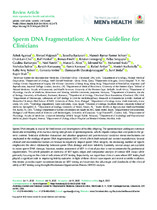| dc.contributor.author | Leisegang, Kristian | |
| dc.contributor.author | Agarwal, Ashok | |
| dc.contributor.author | Majzoub, Ahmad A. | |
| dc.date.accessioned | 2021-01-07T09:18:17Z | |
| dc.date.available | 2021-01-07T09:18:17Z | |
| dc.date.issued | 2020 | |
| dc.identifier.citation | Leisegang, K. et al. (2020). Sperm DNA fragmentation: A new guideline for clinicians. World Journal of Men's Health, 38(4), 412-471 | en_US |
| dc.identifier.issn | 2287-4690 | |
| dc.identifier.uri | 10.5534/WJMH.200128 | |
| dc.identifier.uri | http://hdl.handle.net/10566/5596 | |
| dc.description.abstract | Sperm DNA integrity is crucial for fertilization and development of healthy offspring. The spermatozoon undergoes extensive molecular remodeling of its nucleus during later phases of spermatogenesis, which imparts compaction and protects the genetic content. Testicular (defective maturation and abortive apoptosis) and post-testicular (oxidative stress) mechanisms are implicated in the etiology of sperm DNA fragmentation (SDF), which affects both natural and assisted reproduction. Several clinical and environmental factors are known to negatively impact sperm DNA integrity. An increasing number of reports emphasizes the direct relationship between sperm DNA damage and male infertility. Currently, several assays are available to assess sperm DNA damage, however, routine assessment of SDF in clinical practice is not recommended by professional organizations. | en_US |
| dc.language.iso | en | en_US |
| dc.publisher | Korean Society for Sexual Medicine and Andrology | en_US |
| dc.subject | Assisted reproductive techniques outcome | en_US |
| dc.subject | Clinical guidelines | en_US |
| dc.subject | Infertility | en_US |
| dc.subject | Male | en_US |
| dc.subject | Oxidative stress | en_US |
| dc.title | Sperm DNA fragmentation: A new guideline for clinicians | en_US |
| dc.type | Article | en_US |

